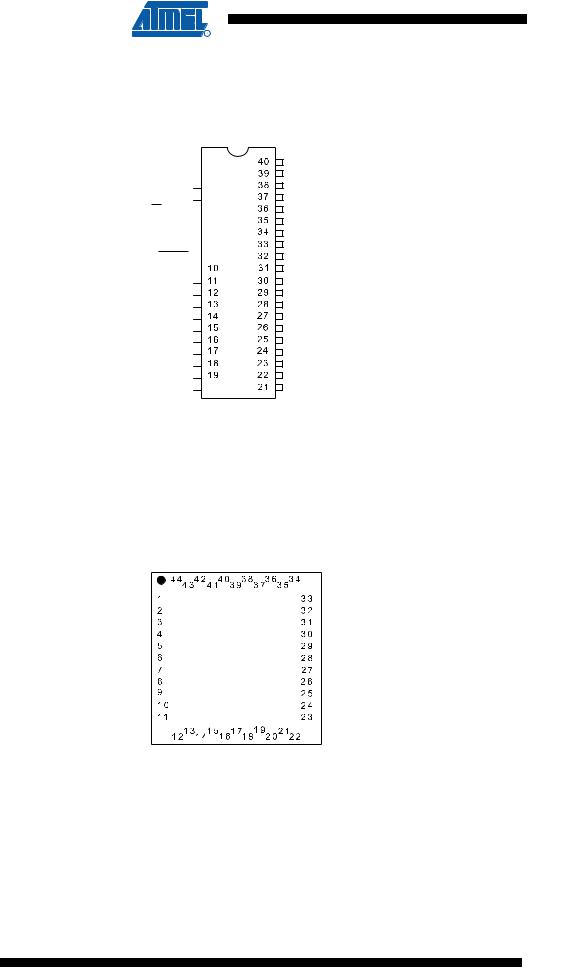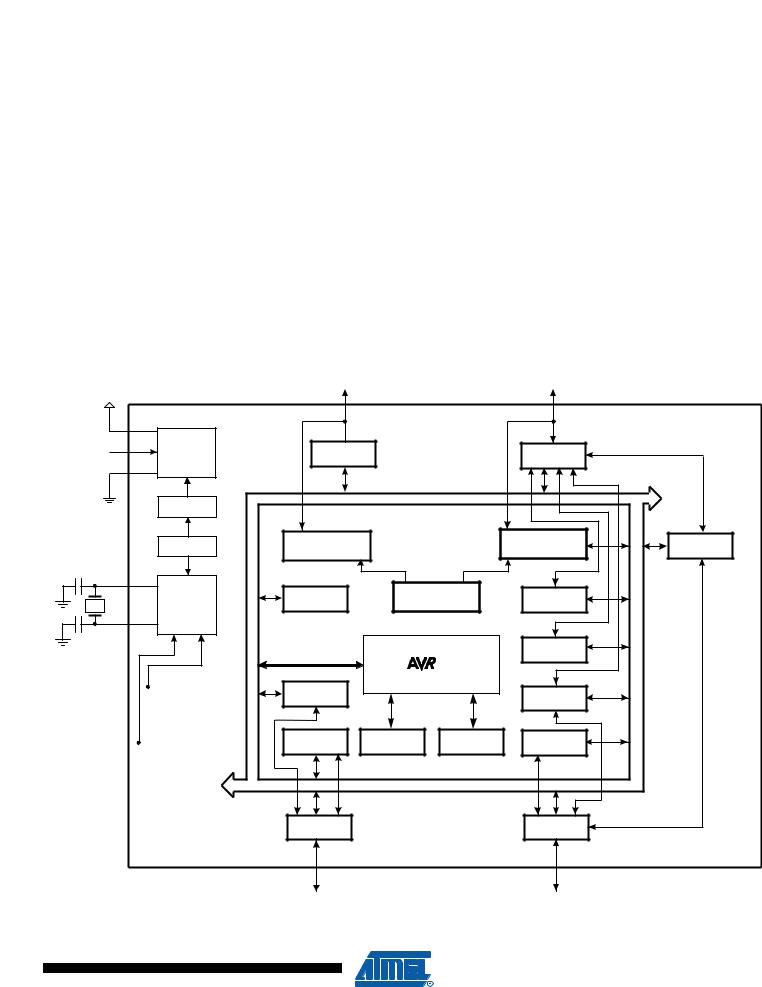ATMEL ATmega644, ATmega644V User Manual

BDTIC www.bdtic.com/ATMEL
Features
•High-performance, Low-power AVR® 8-bit Microcontroller
•Advanced RISC Architecture
–131 Powerful Instructions – Most Single-clock Cycle Execution
–32 x 8 General Purpose Working Registers
–Fully Static Operation
–Up to 20 MIPS Throughput at 20 MHz
•High Endurance Non-volatile Memory segments
–64K Bytes of In-System Self-programmable Flash program memory
–2K Bytes EEPROM
–4K Bytes Internal SRAM
–Write/Erase cyles: 10,000 Flash/100,000 EEPROM(1)(3)
–Data retention: 20 years at 85°C/100 years at 25°C(2)(3)
–Optional Boot Code Section with Independent Lock Bits
In-System Programming by On-chip Boot Program
True Read-While-Write Operation
–Programming Lock for Software Security
•JTAG (IEEE std. 1149.1 Compliant) Interface
–Boundary-scan Capabilities According to the JTAG Standard
–Extensive On-chip Debug Support
–Programming of Flash, EEPROM, Fuses, and Lock Bits through the JTAG Interface
•Peripheral Features
–Two 8-bit Timer/Counters with Separate Prescalers and Compare Modes
–One 16-bit Timer/Counter with Separate Prescaler, Compare Mode, and Capture Mode
–Real Time Counter with Separate Oscillator
–Six PWM Channels
–8-channel, 10-bit ADC
Differential mode with selectable gain at 1x, 10x or 200x
–Byte-oriented Two-wire Serial Interface
–One Programmable Serial USART
–Master/Slave SPI Serial Interface
–Programmable Watchdog Timer with Separate On-chip Oscillator
–On-chip Analog Comparator
–Interrupt and Wake-up on Pin Change
•Special Microcontroller Features
–Power-on Reset and Programmable Brown-out Detection
–Internal Calibrated RC Oscillator
–External and Internal Interrupt Sources
–Six Sleep Modes: Idle, ADC Noise Reduction, Power-save, Power-down, Standby and Extended Standby
•I/O and Packages
–32 Programmable I/O Lines
–40-pin PDIP, 44-lead TQFP, and 44-pad QFN/MLF
•Speed Grades
–ATmega644V: 0 - 4MHz @ 1.8 - 5.5V, 0 - 10MHz @ 2.7 - 5.5V
–ATmega644: 0 - 10MHz @ 2.7 - 5.5V, 0 - 20MHz @ 4.5 - 5.5V
•Power Consumption at 1 MHz, 3V, 25°C for
–Active: 240 µA @ 1.8V, 1MHz
–Power-down Mode: 0.1 µA @ 1.8V
Notes: 1. Worst case temperature. Guaranteed after last write cycle.
2.Failure rate less than 1 ppm.
3.Characterized through accelerated tests.
8-bit
Microcontroller with 64K Bytes In-System Programmable Flash
ATmega644/V
Preliminary
Summary
2593MS–AVR–08/07

1. Pin Configurations
Figure 1-1. Pinout ATmega644
PDIP
(PCINT8/XCK0/T0) PB0 
 (PCINT9/CLKO/T1) PB1
(PCINT9/CLKO/T1) PB1 
 (PCINT10/INT2/AIN0) PB2
(PCINT10/INT2/AIN0) PB2 
 (PCINT11/OC0A/AIN1) PB3
(PCINT11/OC0A/AIN1) PB3 
 (PCINT12/OC0B/SS) PB4
(PCINT12/OC0B/SS) PB4 
 (PCINT13/MOSI) PB5
(PCINT13/MOSI) PB5 
 (PCINT14/MISO) PB6
(PCINT14/MISO) PB6 
 (PCINT15/SCK) PB7
(PCINT15/SCK) PB7 
 RESET
RESET 

VCC 
GND 
XTAL2 
XTAL1  (PCINT24/RXD0) PD0
(PCINT24/RXD0) PD0  (PCINT25/TXD0) PD1
(PCINT25/TXD0) PD1  (PCINT26/INT0) PD2
(PCINT26/INT0) PD2  (PCINT27/INT1) PD3
(PCINT27/INT1) PD3  (PCINT28/OC1B) PD4
(PCINT28/OC1B) PD4  (PCINT29/OC1A) PD5
(PCINT29/OC1A) PD5 
(PCINT30/OC2B/ICP) PD6 


PA0 (ADC0/PCINT0) PA1 (ADC1/PCINT1) PA2 (ADC2/PCINT2) PA3 (ADC3/PCINT3) PA4 (ADC4/PCINT4) PA5 (ADC5/PCINT5) PA6 (ADC6/PCINT6) PA7 (ADC7/PCINT7) AREF
GND
AVCC
PC7 (TOSC2/PCINT23) PC6 (TOSC1/PCINT22) PC5 (TDI/PCINT21)
PC4 (TDO/PCINT20) PC3 (TMS/PCINT19) PC2 (TCK/PCINT18) PC1 (SDA/PCINT17) PC0 (SCL/PCINT16)
PD7 (OC2A/PCINT31)
TQFP/QFN/MLF
|
|
|
|
|
|
PB4 (SS/OC0B/PCINT12) |
PB3 (AIN1/OC0A/PCINT11) |
PB2 (AIN0/INT2/PCINT10) |
PB1 (T1/CLKO/PCINT9) |
PB0 (XCK0/T0/PCINT8) |
GND |
VCC |
PA0 (ADC0/PCINT0) |
PA1 (ADC1/PCINT1) |
PA2 (ADC2/PCINT2) |
PA3 (ADC3/PCINT3) |
||||||||||||||
|
|
|
|
|
|
|||||||||||||||||||||||||
|
|
|
|
|
|
|||||||||||||||||||||||||
|
(PCINT13/MOSI) PB5 |
|
|
|
|
|
|
|
|
|
|
|
|
|
|
|
|
|
|
|
|
|
|
|
|
|
|
PA4 (ADC4/PCINT4) |
||
|
|
|
|
|
|
|
|
|
|
|
|
|
|
|
|
|
|
|
|
|
|
|
|
|
|
|
||||
|
|
|
|
|
|
|
|
|
|
|
|
|
|
|
|
|
|
|
|
|
|
|
|
|
|
|
||||
|
|
|
|
|
|
|
|
|
|
|
|
|
|
|
|
|
|
|
|
|
|
|
|
|
|
|
||||
|
|
|
|
|
|
|
|
|
|
|
|
|
|
|
|
|
|
|
|
|
|
|
|
|
|
|
||||
|
(PCINT14/MISO) PB6 |
|
|
|
|
|
|
|
|
|
|
|
|
|
|
|
|
|
|
|
|
|
|
|
|
|
|
PA5 (ADC5/PCINT5) |
||
|
|
|
|
|
|
|
|
|
|
|
|
|
|
|
|
|
|
|
|
|
|
|
|
|
|
|
||||
|
|
|
|
|
|
|
|
|
|
|
|
|
|
|
|
|
|
|
|
|
|
|
|
|
|
|
||||
|
(PCINT15/SCK) PB7 |
|
|
|
|
|
|
|
|
|
|
|
|
|
|
|
|
|
|
|
|
|
|
|
|
|
|
PA6 (ADC6/PCINT6) |
||
|
|
|
|
|
|
|
|
|
|
|
|
|
|
|
|
|
|
|
|
|
|
|
|
|
|
|
||||
|
|
|
|
|
|
|
|
|
|
|
|
|
|
|
|
|
|
|
|
|
|
|
|
|
|
|
||||
|
|
|
|
|
|
|
|
|
|
|
|
|
|
|
|
|
|
|
|
|
|
|
|
|
|
|
|
|
|
|
|
RESET |
|
|
|
|
|
|
|
|
|
|
|
|
|
|
|
|
|
|
|
|
|
|
|
|
|
|
PA7 (ADC7/PCINT7) |
||
|
|
|
|
|
|
|
|
|
|
|
|
|
|
|
|
|
|
|
|
|
|
|
|
|
|
|
||||
|
|
VCC |
|
|
|
|
|
|
|
|
|
|
|
|
|
|
|
|
|
|
|
|
|
|
|
|
|
|
AREF |
|
|
|
|
|
|
|
|
|
|
|
|
|
|
|
|
|
|
|
|
|
|
|
|
|
|
|
|
||||
|
|
|
|
|
|
|
|
|
|
|
|
|
|
|
|
|
|
|
|
|
|
|
|
|
|
|
||||
|
|
GND |
|
|
|
|
|
|
|
|
|
|
|
|
|
|
|
|
|
|
|
|
|
|
|
|
|
|
GND |
|
|
|
|
|
|
|
|
|
|
|
|
|
|
|
|
|
|
|
|
|
|
|
|
|
|
|
|
||||
|
|
|
|
|
|
|
|
|
|
|
|
|
|
|
|
|
|
|
|
|
|
|
|
|
|
|
||||
|
|
XTAL2 |
|
|
|
|
|
|
|
|
|
|
|
|
|
|
|
|
|
|
|
|
|
|
|
|
|
|
AVCC |
|
|
|
|
|
|
|
|
|
|
|
|
|
|
|
|
|
|
|
|
|
|
|
|
|
|
|
|
||||
|
|
|
|
|
|
|
|
|
|
|
|
|
|
|
|
|
|
|
|
|
|
|
|
|
|
|
||||
|
|
XTAL1 |
|
|
|
|
|
|
|
|
|
|
|
|
|
|
|
|
|
|
|
|
|
|
|
|
|
|
PC7 (TOSC2/PCINT23) |
|
|
|
|
|
|
|
|
|
|
|
|
|
|
|
|
|
|
|
|
|
|
|
|
|
|
|
|
||||
|
|
|
|
|
|
|
|
|
|
|
|
|
|
|
|
|
|
|
|
|
|
|
|
|
|
|
||||
|
(PCINT24/RXD0) PD0 |
|
|
|
|
|
|
|
|
|
|
|
|
|
|
|
|
|
|
|
|
|
|
|
|
|
|
PC6 (TOSC1/PCINT22) |
||
|
|
|
|
|
|
|
|
|
|
|
|
|
|
|
|
|
|
|
|
|
|
|
|
|
|
|
||||
|
|
|
|
|
|
|
|
|
|
|
|
|
|
|
|
|
|
|
|
|
|
|
|
|
|
|
||||
|
(PCINT25/TXD0) PD1 |
|
|
|
|
|
|
|
|
|
|
|
|
|
|
|
|
|
|
|
|
|
|
|
|
|
|
PC5 (TDI/PCINT21) |
||
|
|
|
|
|
|
|
|
|
|
|
|
|
|
|
|
|
|
|
|
|
|
|
|
|
|
|
||||
|
|
|
|
|
|
|
|
|
|
|
|
|
|
|
|
|
|
|
|
|
|
|
|
|
|
|
||||
|
(PCINT26/INT0) PD2 |
|
|
|
|
|
|
|
|
|
|
|
|
|
|
|
|
|
|
|
|
|
|
|
|
|
|
PC4 (TDO/PCINT20) |
||
|
|
|
|
|
|
|
|
|
|
|
|
|
|
|
|
|
|
|
|
|
|
|
|
|
|
|
||||
|
|
|
|
|
|
|
|
|
|
|
|
|
|
|
|
|
|
|
|
|
|
|
||||||||
|
|
|
|
|
|
|
|
|
|
|
|
|
|
|
|
|
|
|
|
|
|
|
|
|
|
|
|
|
|
|
|
|
|
|
|
|
|
PD3 |
|
PD4 |
PD5 |
PD6 |
PD7 |
VCC |
GND |
PC0 |
PC1 |
PC2 |
PC3 |
||||||||||||
|
|
|
|
|
|
|
(PCINT27/INT1) |
|
(PCINT28/OC1B) |
(PCINT29/OC1A) |
(PCINT30/OC2B/ICP) |
(PCINT31/OC2A) |
|
|
|
|
(PCINT16/SCL) |
(PCINT17/SDA) |
(PCINT18/TCK) |
(PCINT19/TMS) |
||||||||||
Note: |
The large center pad underneath the QFN/MLF package should be soldered to ground on the |
|||||||||||||||||||||||||||||
board to ensure good mechanical stability.
2 ATmega644
2593MS–AVR–08/07

 ATmega644
ATmega644
1.1Disclaimer
Typical values contained in this datasheet are based on simulations and characterization of other AVR microcontrollers manufactured on the same process technology. Min and Max values will be available after the device is characterized.
2. Overview
The ATmega644 is a low-power CMOS 8-bit microcontroller based on the AVR enhanced RISC architecture. By executing powerful instructions in a single clock cycle, the ATmega644 achieves throughputs approaching 1 MIPS per MHz allowing the system designer to optimize power consumption versus processing speed.
2.1Block Diagram
Figure 2-1. Block Diagram
VCC
RESET
GND
XTAL1
XTAL2
|
PA7..0 |
|
|
PB7..0 |
|
Power |
|
|
|
|
|
Supervision |
PORT A (8) |
|
|
PORT B (8) |
|
POR / BOD & |
|
|
|
||
RESET |
|
|
|
|
|
Watchdog |
|
|
|
|
|
Timer |
|
|
|
|
|
Watchdog |
A/D |
|
|
Analog |
USART 0 |
Oscillator |
Converter |
|
|
Comparator |
|
|
|
|
|||
Oscillator |
EEPROM |
|
Internal |
SPI |
|
Circuits / |
Bandgap reference |
|
|||
Clock |
|
|
|
|
|
Generation |
|
|
|
|
|
|
|
|
|
16bit T/C 1 |
|
|
|
|
CPU |
|
|
|
JTAG |
|
|
8bit T/C 0 |
|
|
|
|
|
|
|
|
TWI |
FLASH |
SRAM |
8bit T/C 2 |
|
|
PORT C (8) |
|
|
PORT D (8) |
|
|
PC7..0 |
|
|
PD7..0 |
|
3
2593MS–AVR–08/07

The AVR core combines a rich instruction set with 32 general purpose working registers. All the 32 registers are directly connected to the Arithmetic Logic Unit (ALU), allowing two independent registers to be accessed in one single instruction executed in one clock cycle. The resulting architecture is more code efficient while achieving throughputs up to ten times faster than conventional CISC microcontrollers.
The ATmega644 provides the following features: 64K bytes of In-System Programmable Flash with Read-While-Write capabilities, 2K bytes EEPROM, 4K bytes SRAM, 32 general purpose I/O lines, 32 general purpose working registers, Real Time Counter (RTC), three flexible Timer/Counters with compare modes and PWM, 2 USARTs, a byte oriented 2-wire Serial Interface, a 8-channel, 10-bit ADC with optional differential input stage with programmable gain, programmable Watchdog Timer with Internal Oscillator, an SPI serial port, IEEE std. 1149.1 compliant JTAG test interface, also used for accessing the On-chip Debug system and programming and six software selectable power saving modes. The Idle mode stops the CPU while allowing the SRAM, Timer/Counters, SPI port, and interrupt system to continue functioning. The Power-down mode saves the register contents but freezes the Oscillator, disabling all other chip functions until the next interrupt or Hardware Reset. In Power-save mode, the asynchronous timer continues to run, allowing the user to maintain a timer base while the rest of the device is sleeping. The ADC Noise Reduction mode stops the CPU and all I/O modules except Asynchronous Timer and ADC, to minimize switching noise during ADC conversions. In Standby mode, the Crystal/Resonator Oscillator is running while the rest of the device is sleeping. This allows very fast start-up combined with low power consumption. In Extended Standby mode, both the main Oscillator and the Asynchronous Timer continue to run.
The device is manufactured using Atmel’s high-density nonvolatile memory technology. The Onchip ISP Flash allows the program memory to be reprogrammed in-system through an SPI serial interface, by a conventional nonvolatile memory programmer, or by an On-chip Boot program running on the AVR core. The boot program can use any interface to download the application program in the application Flash memory. Software in the Boot Flash section will continue to run while the Application Flash section is updated, providing true Read-While-Write operation. By combining an 8-bit RISC CPU with In-System Self-Programmable Flash on a monolithic chip, the Atmel ATmega644 is a powerful microcontroller that provides a highly flexible and cost effective solution to many embedded control applications.
The ATmega644 AVR is supported with a full suite of program and system development tools including: C compilers, macro assemblers, program debugger/simulators, in-circuit emulators, and evaluation kits.
2.2Pin Descriptions
2.2.1VCC
Digital supply voltage.
2.2.2GND
Ground.
2.2.3Port A (PA7:PA0)
Port A serves as analog inputs to the Analog-to-digital Converter.
Port A also serves as an 8-bit bi-directional I/O port with internal pull-up resistors (selected for each bit). The Port A output buffers have symmetrical drive characteristics with both high sink
4 ATmega644 
2593MS–AVR–08/07

 ATmega644
ATmega644
and source capability. As inputs, Port A pins that are externally pulled low will source current if the pull-up resistors are activated. The Port A pins are tri-stated when a reset condition becomes active, even if the clock is not running.
Port A also serves the functions of various special features of the ATmega644 as listed on page 73.
2.2.4Port B (PB7:PB0)
Port B is an 8-bit bi-directional I/O port with internal pull-up resistors (selected for each bit). The Port B output buffers have symmetrical drive characteristics with both high sink and source capability. As inputs, Port B pins that are externally pulled low will source current if the pull-up resistors are activated. The Port B pins are tri-stated when a reset condition becomes active, even if the clock is not running.
Port B also serves the functions of various special features of the ATmega644 as listed on page 75.
2.2.5Port C (PC7:PC0)
Port C is an 8-bit bi-directional I/O port with internal pull-up resistors (selected for each bit). The Port C output buffers have symmetrical drive characteristics with both high sink and source capability. As inputs, Port C pins that are externally pulled low will source current if the pull-up resistors are activated. The Port C pins are tri-stated when a reset condition becomes active, even if the clock is not running.
Port C also serves the functions of the JTAG interface, along with special features of the ATmega644 as listed on page 78.
2.2.6Port D (PD7:PD0)
Port D is an 8-bit bi-directional I/O port with internal pull-up resistors (selected for each bit). The Port D output buffers have symmetrical drive characteristics with both high sink and source capability. As inputs, Port D pins that are externally pulled low will source current if the pull-up resistors are activated. The Port D pins are tri-stated when a reset condition becomes active, even if the clock is not running.
Port D also serves the functions of various special features of the ATmega644 as listed on page 80.
2.2.7RESET
Reset input. A low level on this pin for longer than the minimum pulse length will generate a reset, even if the clock is not running. The minimum pulse length is given in ”System and Reset Characteristics” on page 320. Shorter pulses are not guaranteed to generate a reset.
2.2.8XTAL1
Input to the inverting Oscillator amplifier and input to the internal clock operating circuit.
2.2.9XTAL2
Output from the inverting Oscillator amplifier.
5
2593MS–AVR–08/07

2.2.10AVCC
AVCC is the supply voltage pin for Port F and the Analog-to-digital Converter. It should be externally connected to VCC, even if the ADC is not used. If the ADC is used, it should be connected to VCC through a low-pass filter.
2.2.11AREF
This is the analog reference pin for the Analog-to-digital Converter.
3. Resources
A comprehensive set of development tools, application notes and datasheetsare available for download on http://www.atmel.com/avr.
6 ATmega644 
2593MS–AVR–08/07

 ATmega644
ATmega644
4. |
Register Summary |
|
|
|
|
|
|
|
|
|
|
|||
|
|
|
|
|
|
|
|
|
|
|
|
|
|
|
|
Address |
Name |
Bit 7 |
|
Bit 6 |
Bit 5 |
Bit 4 |
Bit 3 |
|
Bit 2 |
Bit 1 |
|
Bit 0 |
Page |
|
|
|
|
|
|
|
|
|
|
|
|
|
|
|
|
(0xFF) |
Reserved |
- |
|
- |
- |
- |
|
|
- |
- |
|
- |
|
|
(0xFE) |
Reserved |
- |
|
- |
- |
- |
- |
|
- |
- |
|
- |
|
|
(0xFD) |
Reserved |
- |
|
- |
- |
- |
- |
|
- |
- |
|
- |
|
|
(0xFC) |
Reserved |
- |
|
- |
- |
- |
- |
|
- |
- |
|
- |
|
|
(0xFB) |
Reserved |
- |
|
- |
- |
- |
|
|
- |
- |
|
- |
|
|
(0xFA) |
Reserved |
- |
|
- |
- |
- |
- |
|
- |
- |
|
- |
|
|
(0xF9) |
Reserved |
- |
|
- |
- |
- |
|
|
- |
- |
|
- |
|
|
(0xF8) |
Reserved |
- |
|
- |
- |
- |
- |
|
- |
- |
|
- |
|
|
(0xF7) |
Reserved |
- |
|
- |
- |
- |
- |
|
- |
- |
|
- |
|
|
(0xF6) |
Reserved |
- |
|
- |
- |
- |
- |
|
- |
- |
|
- |
|
|
(0xF5) |
Reserved |
- |
|
- |
- |
- |
|
|
- |
- |
|
- |
|
|
(0xF4) |
Reserved |
- |
|
- |
- |
- |
- |
|
- |
- |
|
- |
|
|
(0xF3) |
Reserved |
- |
|
- |
- |
- |
- |
|
- |
- |
|
- |
|
|
(0xF2) |
Reserved |
- |
|
- |
- |
- |
- |
|
- |
- |
|
- |
|
|
(0xF1) |
Reserved |
- |
|
- |
- |
- |
|
|
- |
- |
|
- |
|
|
(0xF0) |
Reserved |
- |
|
- |
- |
- |
- |
|
- |
- |
|
- |
|
|
(0xEF) |
Reserved |
- |
|
- |
- |
- |
|
|
- |
- |
|
- |
|
|
(0xEE) |
Reserved |
- |
|
- |
- |
- |
- |
|
- |
- |
|
- |
|
|
(0xED) |
Reserved |
- |
|
- |
- |
- |
- |
|
- |
- |
|
- |
|
|
(0xEC) |
Reserved |
- |
|
- |
- |
- |
- |
|
- |
- |
|
- |
|
|
(0xEB) |
Reserved |
- |
|
- |
- |
- |
|
|
- |
- |
|
- |
|
|
(0xEA) |
Reserved |
- |
|
- |
- |
- |
- |
|
- |
- |
|
- |
|
|
(0xE9) |
Reserved |
- |
|
- |
- |
- |
- |
|
- |
- |
|
- |
|
|
(0xE8) |
Reserved |
- |
|
- |
- |
- |
- |
|
- |
- |
|
- |
|
|
(0xE7) |
Reserved |
- |
|
- |
- |
- |
|
|
- |
- |
|
- |
|
|
(0xE6) |
Reserved |
- |
|
- |
- |
- |
- |
|
- |
- |
|
- |
|
|
(0xE5) |
Reserved |
- |
|
- |
- |
- |
- |
|
- |
- |
|
- |
|
|
(0xE4) |
Reserved |
- |
|
- |
- |
- |
- |
|
- |
- |
|
- |
|
|
(0xE3) |
Reserved |
- |
|
- |
- |
- |
|
|
- |
- |
|
- |
|
|
(0xE2) |
Reserved |
- |
|
- |
- |
- |
- |
|
- |
- |
|
- |
|
|
(0xE1) |
Reserved |
- |
|
- |
- |
- |
|
|
- |
- |
|
- |
|
|
(0xE0) |
Reserved |
- |
|
- |
- |
- |
|
|
- |
- |
|
- |
|
|
(0xDF) |
Reserved |
- |
|
- |
- |
- |
- |
|
- |
- |
|
- |
|
|
(0xDE) |
Reserved |
- |
|
- |
- |
- |
- |
|
- |
- |
|
- |
|
|
(0xDD) |
Reserved |
- |
|
- |
- |
- |
- |
|
- |
- |
|
- |
|
|
(0xDC) |
Reserved |
- |
|
- |
- |
- |
|
|
- |
- |
|
- |
|
|
(0xDB) |
Reserved |
- |
|
- |
- |
- |
- |
|
- |
- |
|
- |
|
|
(0xDA) |
Reserved |
- |
|
- |
- |
- |
- |
|
- |
- |
|
- |
|
|
(0xD9) |
Reserved |
- |
|
- |
- |
- |
- |
|
- |
- |
|
- |
|
|
(0xD8) |
Reserved |
- |
|
- |
- |
- |
- |
|
- |
- |
|
- |
|
|
(0xD7) |
Reserved |
- |
|
- |
- |
- |
- |
|
- |
- |
|
- |
|
|
(0xD6) |
Reserved |
- |
|
- |
- |
- |
- |
|
- |
- |
|
- |
|
|
(0xD5) |
Reserved |
- |
|
- |
- |
- |
- |
|
- |
- |
|
- |
|
|
(0xD4) |
Reserved |
- |
|
- |
- |
- |
- |
|
- |
- |
|
- |
|
|
(0xD3) |
Reserved |
- |
|
- |
- |
- |
- |
|
- |
- |
|
- |
|
|
(0xD2) |
Reserved |
- |
|
- |
- |
- |
- |
|
- |
- |
|
- |
|
|
(0xD1) |
Reserved |
- |
|
- |
- |
- |
- |
|
- |
- |
|
- |
|
|
(0xD0) |
Reserved |
- |
|
- |
- |
- |
- |
|
- |
- |
|
- |
|
|
(0xCF) |
Reserved |
- |
|
- |
- |
- |
- |
|
- |
- |
|
- |
|
|
(0xCE) |
Reserved |
- |
|
- |
- |
- |
- |
|
- |
- |
|
- |
|
|
(0xCD) |
Reserved |
- |
|
- |
- |
- |
- |
|
- |
- |
|
- |
|
|
(0xCC) |
Reserved |
- |
|
- |
- |
- |
- |
|
- |
- |
|
- |
|
|
(0xCB) |
Reserved |
- |
|
- |
- |
- |
- |
|
- |
- |
|
- |
|
|
(0xCA) |
Reserved |
- |
|
- |
- |
- |
- |
|
- |
- |
|
- |
|
|
(0xC9) |
Reserved |
- |
|
- |
- |
- |
- |
|
- |
- |
|
- |
|
|
(0xC8) |
Reserved |
- |
|
- |
- |
- |
- |
|
- |
- |
|
- |
|
|
(0xC7) |
Reserved |
- |
|
- |
- |
- |
- |
|
- |
- |
|
- |
|
|
(0xC6) |
UDR0 |
|
|
|
|
USART0 I/O Data Register |
|
|
|
|
|
182 |
|
|
(0xC5) |
UBRR0H |
- |
|
- |
- |
- |
|
USART0 Baud Rate Register High Byte |
|
186/198 |
|||
|
(0xC4) |
UBRR0L |
|
|
|
|
USART0 Baud Rate Register Low Byte |
|
|
|
186/198 |
|||
|
(0xC3) |
Reserved |
- |
|
- |
- |
- |
- |
|
- |
- |
|
- |
|
|
(0xC2) |
UCSR0C |
UMSEL01 |
|
UMSEL00 |
UPM01 |
UPM00 |
USBS0 |
|
UCSZ01 |
UCSZ00 |
|
UCPOL0 |
184/197 |
|
(0xC1) |
UCSR0B |
RXCIE0 |
|
TXCIE0 |
UDRIE0 |
RXEN0 |
TXEN0 |
|
UCSZ02 |
RXB80 |
|
TXB80 |
183/197 |
|
(0xC0) |
UCSR0A |
RXC0 |
|
TXC0 |
UDRE0 |
FE0 |
DOR0 |
|
UPE0 |
U2X0 |
|
MPCM0 |
182/196 |
7
2593MS–AVR–08/07
